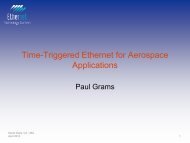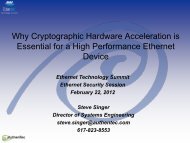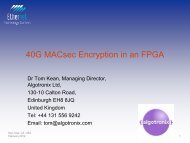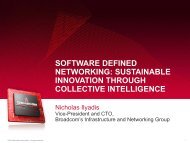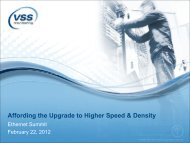Full TCP & UDP Offload Core and Systems Ultra high Performance ...
Full TCP & UDP Offload Core and Systems Ultra high Performance ...
Full TCP & UDP Offload Core and Systems Ultra high Performance ...
Create successful ePaper yourself
Turn your PDF publications into a flip-book with our unique Google optimized e-Paper software.
<strong>Full</strong> <strong>TCP</strong> & <strong>UDP</strong> <strong>Offload</strong><br />
<strong>Core</strong> <strong>and</strong> <strong>Systems</strong><br />
for<br />
<strong>Ultra</strong> <strong>high</strong> <strong>Performance</strong><br />
Network Equipment<br />
Delivering 20G Line rate <strong>Performance</strong> with<br />
<strong>Ultra</strong> low latency<br />
A TOE Story<br />
Santa Clara, CA USA<br />
April 2013<br />
intilop Corporation<br />
4800 Great America Pkwy. Ste-231<br />
Santa Clara, CA. 95054<br />
Ph: 408-496-0333, Fax: 408-496-0444<br />
www.intilop.com<br />
1
Topics<br />
Content<br />
Slide<br />
- Network Traffic growth ………………………… 3<br />
- <strong>TCP</strong>/<strong>UDP</strong>/IP in Networks ……………………...… 5<br />
- <strong>TCP</strong>/<strong>UDP</strong> <strong>Offload</strong> VS Non <strong>Offload</strong> …………...… 6<br />
- Why <strong>TCP</strong>/<strong>UDP</strong>/IP Software is too slow …….…8<br />
- Market Opportunity ……………………….………12<br />
- Required Protocol Layers…………………..…….13<br />
- Why In FPGA …………………………………....15<br />
- Intilop’s TOE/UOE – Key Features ………..…....18<br />
- 10 G bit TOE – Architecture ………………………21<br />
Santa Clara, CA USA<br />
April 2013<br />
2
Network Traffic Growth<br />
Global IP traffic will increase fivefold by 2015:<br />
TOE<br />
Global IP traffic is expected to increase fivefold from 2011 to 2016,<br />
approaching 70 exabytes per month in 2015, up from approximately<br />
11 exabytes per month in 2010.<br />
By 2016, annual global IP traffic will reach about 0.7of a zettabyte.<br />
IP traffic in North America will reach 13 exabytes per month by 2015,<br />
slightly ahead of Western Europe, which will reach 12.5 exabytes<br />
per month, <strong>and</strong> behind Asia Pacific (AsiaPac), where IP traffic will<br />
reach 21 exabytes per month<br />
Middle East <strong>and</strong> Africa will grow the fastest, with a compound annual<br />
growth rate of 51 percent, reaching 1 exabyte per month in 2016.<br />
An optimized <strong>TCP</strong> stack running on a Xeon Class CPU – @2.x GHz<br />
when dedicated to just one Ethernet port can h<strong>and</strong>le data rate of up<br />
to about 500 MHz before slowing down.<br />
Terabyte (TB) 10 12 2 40<br />
Petabyte (PB) 10 15 2 50<br />
exabyte (EB) 10 18 2 60<br />
Zettabyte (ZB) 10 21 2 70<br />
Santa Clara, CA USA<br />
April 2013<br />
Yottabyte (YB) 10 24 2 80<br />
3
<strong>TCP</strong>/<strong>UDP</strong>/IP in Networks & Challenges<br />
- Increasing <strong>TCP</strong>/IP performance<br />
has been a major research area for<br />
the networking system designers.<br />
- Many incremental improvements,<br />
such as <strong>TCP</strong> checksum offload have<br />
since become widely adopted.<br />
- However, these improvements only<br />
serve to keep the problem from<br />
getting worse over time, as they do<br />
not solve the network scalability<br />
problem caused by increasing<br />
disparity of improvement of CPU<br />
speed, memory b<strong>and</strong>width,<br />
memory latency <strong>and</strong> network<br />
<strong>and</strong>width.<br />
- At multigigabit data rates,<br />
<strong>TCP</strong>/<strong>UDP</strong>/IP processing is still a<br />
major source<br />
of system overhead.<br />
Server<br />
TOE<br />
NAS or DB Server<br />
SAN Storage<br />
Santa Clara, CA USA<br />
April 2013<br />
4
<strong>TCP</strong>/<strong>UDP</strong> <strong>Offload</strong> VS Non <strong>Offload</strong><br />
Applications /Upper level Protocols<br />
Applications<br />
Application-<br />
Socket<br />
API<br />
Socket API<br />
St<strong>and</strong>ard<br />
<strong>TCP</strong><br />
Protocol<br />
Software<br />
Stack<br />
(Linux or<br />
Windows)<br />
Sockets/Buffers-Map<br />
Layer 4 <strong>TCP</strong> Layer<br />
Layer 3 IP Layer<br />
<strong>Full</strong><br />
<strong>TCP</strong>/<strong>UDP</strong><br />
<strong>Offload</strong><br />
(intilop)<br />
Layer 2 MAC<br />
PHY<br />
PHY<br />
Current <strong>TCP</strong>/IP Software Architecture<br />
<strong>TCP</strong> <strong>Offload</strong> Architecture<br />
Santa Clara, CA USA<br />
April 2013<br />
5
Various degrees of <strong>TCP</strong>/<strong>UDP</strong> <strong>Offload</strong><br />
Traditional <strong>TCP</strong>/IP<br />
Implementation<br />
Enhanced <strong>TCP</strong>/IP<br />
(Partial <strong>Offload</strong> in a few designs)<br />
Applications<br />
Intilop<br />
<strong>Full</strong>_<strong>TCP</strong> <strong>Offload</strong><br />
Applications<br />
MAC+TOE+UOE<br />
Applications<br />
Remaining_<strong>TCP</strong><br />
Functions - CPU<br />
Partial_TOE<br />
(Hardware Assist)<br />
MAC<br />
St<strong>and</strong>ard<br />
<strong>TCP</strong>/<strong>UDP</strong>/IP<br />
Protocol<br />
Software<br />
Stack<br />
(Linux or<br />
Windows)<br />
MAC<br />
PHY PHY PHY<br />
Santa Clara, CA USA<br />
April 2013<br />
6
Why <strong>TCP</strong>/IP Software is too slow<br />
Traditional methods to reduce <strong>TCP</strong>/IP overhead offer limited gains:<br />
•After an application sends data across a network, several data movement<br />
<strong>and</strong> protocol-processing steps occur. These <strong>and</strong> other <strong>TCP</strong> activities<br />
consume critical host resources:<br />
• The application writes the transmit data to the <strong>TCP</strong>/IP sockets interface for<br />
transmission in payload sizes ranging from 4 KB to 64 KB.<br />
• The OS segments the data into maximum transmission unit (MTU)–size<br />
packets, <strong>and</strong> then adds <strong>TCP</strong>/IP header information to each packet.<br />
Santa Clara, CA USA<br />
April 2013<br />
7
Why <strong>TCP</strong>/IP Software is Slow<br />
• The OS copies the data onto the network interface card ‘s(NIC)<br />
send queue.<br />
• The NIC performs the direct memory access (DMA) transfer of<br />
each data packet from the <strong>TCP</strong> buffer space to the NIC, <strong>and</strong><br />
interrupts CPU to indicate completion of the transfer.<br />
•The two most popular methods to reduce the substantial CPU<br />
overhead that <strong>TCP</strong>/IP processing incurs are <strong>TCP</strong>/IP checksum<br />
offload <strong>and</strong> large send offload.<br />
Santa Clara, CA USA<br />
April 2013<br />
8
Why <strong>TCP</strong>/IP Software is Slow<br />
•<strong>TCP</strong>/IP checksum offload:<br />
•<strong>Offload</strong>s calculation of Checksum function to hardware.<br />
•Resulting in speeding up by 8-15%<br />
•Large send offload (LSO) or <strong>TCP</strong> segmentation offload (TSO):<br />
Relieves the OS from the task of segmenting the application’s transmit<br />
data into MTU-size chunks. Using LSO, <strong>TCP</strong> can transmit a chunk of data<br />
larger than the MTU size to the network adapter. The adapter driver then<br />
divides the data into MTU-size chunks <strong>and</strong> uses an early copy <strong>TCP</strong> <strong>and</strong> IP<br />
headers of the send buffer to create <strong>TCP</strong>/IP headers for each packet in<br />
preparation for transmission.<br />
Santa Clara, CA USA<br />
April 2013<br />
9
Why <strong>TCP</strong>/IP Software is too Slow<br />
•CPU interrupt processing:<br />
An application that generates a write to a remote host over a network<br />
produces a series of interrupts to segment the data into packets <strong>and</strong><br />
process the incoming acknowledgments. H<strong>and</strong>ling each interrupt<br />
creates a significant amount of context switching<br />
•All these tasks end up taking 10s of thous<strong>and</strong>s of lines of code.<br />
•There are optimized versions of <strong>TCP</strong>/IP software running which<br />
acheive 10-30% performance improvement;<br />
•Question is: Is that enough<br />
Santa Clara, CA USA<br />
April 2013<br />
10
Market Opportunity<br />
Accelerated Financial Transactions, deep packet inspection<br />
<strong>and</strong> storage data processing requires ultra-fast, <strong>high</strong>ly<br />
intelligent information processing <strong>and</strong> Storage/retrieval-<br />
Problem:<br />
The critical functions <strong>and</strong> elements that are traditionally<br />
performed by software <strong>and</strong> can not meet today’s<br />
performance requirements.<br />
Response:<br />
-We developed the critical building blocks in ‘Pure-Hardware<br />
creating Mega IPs’ to perform these tasks with lightning<br />
speed.<br />
Santa Clara, CA USA<br />
April 2013<br />
11
Required Protocol Layers<br />
Layer-1<br />
Layer-2 hdr Layer-3 hdr Layer-4 hdr Layer-5/6/7 - App<br />
CPU<br />
TDI/App<br />
Update Cntrl<br />
write<br />
Payload<br />
Read<br />
Payload<br />
Cntrl Read<br />
Mem<br />
Flow n<br />
Flow 0<br />
Descr n<br />
Sockt-App_buff<br />
Checksum+<br />
Strip header<br />
Read Pkt<br />
Descr_n<br />
Descr 0<br />
Payld n<br />
Payld 0<br />
Rx Pkt<br />
Layer 3 IP Layer<br />
Layer 2 MAC<br />
PHY<br />
Santa Clara, CA USA<br />
April 2013<br />
12
<strong>TCP</strong>/IP protocol hardware implementation<br />
App<br />
Rx<br />
Buf<br />
App<br />
Tx<br />
Buf<br />
CPU<br />
Mem<br />
App<br />
Flow_n<br />
Applications<br />
TOE-FPGA<br />
(4 Layers<br />
Integrated)<br />
Update Cntrl<br />
Write payload<br />
Read Payload<br />
Cntrl Read<br />
Checksum+<br />
Strip header<br />
Flow_0<br />
Descr_n<br />
Sockt-App_buff<br />
Descr_n Payld_n<br />
Read Pkt<br />
Descr_0<br />
Payld_0<br />
Rx Pkt<br />
Layer - 3 IP Layer<br />
Layer -2 MAC<br />
PHY<br />
Santa Clara, CA USA<br />
April 2013<br />
13
Why In FPGA<br />
•Flexibility of Technology <strong>and</strong> Architecture-<br />
•By design, FPGA technology is much more conducive <strong>and</strong> adaptive to<br />
innovative ideas <strong>and</strong> implementation of them in hardware<br />
•Allows you to easily carve up the localized memory utilization in sizes<br />
varying from 640 bits to 144K bits based upon dynamic needs of the<br />
number of sessions <strong>and</strong> performance desired that is based on FPGA’s<br />
Slices/ALE/LUT + blk RAM availability.<br />
•Availability of existing mature <strong>and</strong> st<strong>and</strong>ard hard IPcores makes it<br />
possible to easily integrate them <strong>and</strong> build the whole system that is at<br />
the cutting edge of technology.<br />
Santa Clara, CA USA<br />
April 2013<br />
14
Why in FPGA<br />
•Speed <strong>and</strong> ease of development<br />
•A typical design mod/bug fix can be done in a few hours vs<br />
several months in ASIC flow<br />
•Most tools used to design with FPGAs are available much<br />
more readily, are inexpensive <strong>and</strong> are easy to use than ASIC<br />
design tools.<br />
•FPGAs have become a defacto st<strong>and</strong>ard to start<br />
development with<br />
•Much more cost effective to develop<br />
Santa Clara, CA USA<br />
April 2013<br />
15
Why in FPGA<br />
•Spec changes<br />
•<strong>TCP</strong> spec updates/RFC updates are easily adaptable.<br />
•Design Spec changes are implemented more easily<br />
•Future enhancements<br />
•Addition of features, Improvements in code for <strong>high</strong>er<br />
throughput/lower latency, upgrading to 40G/100G are much<br />
easier.<br />
•Next generation products can be introduced much faster<br />
<strong>and</strong> cheaper<br />
Santa Clara, CA USA<br />
April 2013<br />
16
Intilop’s TOE/UOE – Key Features<br />
•Scalability <strong>and</strong> Design Flexibility<br />
•The architecture can be scaled up to 40G MAC+TOE/UOE<br />
• Scalability of internal FIFO/Mem from 64 bytes to 16K bytes that can<br />
be allocated on a per session basis <strong>and</strong> to accommodate very ‘Large<br />
Send’ data for even <strong>high</strong>er throughput.<br />
•Implements an optimized <strong>and</strong> simplified ‘Data Streaming interface’<br />
(No INTRs, Asynchronous communication between User <strong>and</strong> TOE)<br />
•Asynchronous User interface that can run over a range of Clk speeds<br />
for flexibility.<br />
•Gives user the ability to target to slower <strong>and</strong> cheaper FPGA devices.<br />
Santa Clara, CA USA<br />
April 2013<br />
17
Intilop’s TOE – Key Features<br />
•Easy hardware <strong>and</strong> Software integration;<br />
•St<strong>and</strong>ard FIFO interface with User hardware for Payload.<br />
•Integrated <strong>Ultra</strong>-low latency PCIe/DMA in NIC<br />
•St<strong>and</strong>ard Embedded CPU interface for control<br />
•Easy integration in Linux/Windows. Runs in ‘Kernel_bypass’ mode in ‘user_space’<br />
•<strong>Performance</strong> Advantage<br />
•Line rate <strong>TCP</strong> performance.<br />
• Delivers 97% of theoretical network b<strong>and</strong>width <strong>and</strong> 100% of <strong>TCP</strong><br />
b<strong>and</strong>width. 4x – 6x better utilization of existing pipe’s capacities<br />
• No need to do “Load balancing’ in switch ports resulting in reduced<br />
number of ‘Switch Ports’ <strong>and</strong> number of Servers/ports.<br />
• Latency for <strong>TCP</strong> <strong>Offload</strong>: ~100 ns. Compared to 50 us for CPU.<br />
•Patented Search Engine Technology being utilized in critical areas of TOE design to<br />
obtain fastest results.<br />
Santa Clara, CA USA<br />
April 2013<br />
18
10 G bit TOE - Key Features<br />
• Complete Control <strong>and</strong> Data plane processing of <strong>TCP</strong>/<strong>UDP</strong>/IP<br />
sessions in hardware accelerates by 10 x – 20 x<br />
• <strong>TCP</strong>/<strong>UDP</strong> <strong>Offload</strong> Engine- 20G b/s (full duplex) performance<br />
• Scalable to 80 G b/s<br />
• 1-256 Sessions, depending upon on-chip memory availability<br />
• <strong>TCP</strong>/<strong>UDP</strong> + IP check sum- hardware<br />
• Session setup, teardown <strong>and</strong> payload transfer done by<br />
hardware. No CPU involvement.<br />
• Integrated 10 G bit Ethernet MAC.<br />
• Xilinx or Altera CPU interfaces<br />
• Out of sequence packet detection/storage/Reassembly(opt)<br />
• MAC Address search logic/filter (opt)<br />
• Accelerate security processing, Storage Networking- <strong>TCP</strong><br />
• DDMA- Data placement in Applications buffer<br />
-> reduces CPU utilization by 95 +%<br />
• Future Proof- Flexible implementation of <strong>TCP</strong> <strong>Offload</strong><br />
• Accommodates future Specifications changes.<br />
• Customizable. Netlist, Encrypted Source code- Verilog,<br />
• Verilog Models, Perl models, Verification suite.<br />
• Available ; Now<br />
Santa Clara, CA USA<br />
April 2013<br />
19
Intilop’s Network Acceleration & Security Engines<br />
•These main building block IPs that are integral components<br />
for Network Security engine that performs deep packet<br />
inspection of network traffic at multi G bit line rate,<br />
sustained, full duplex.<br />
1.10 G bit <strong>TCP</strong>/<strong>UDP</strong> <strong>Offload</strong> Engine<br />
2.1 G bit <strong>TCP</strong> <strong>Offload</strong> engine<br />
3.<strong>Ultra</strong>-Low Latency DMA/PCIe controller<br />
4.10-G Ethernet MAC<br />
5.1-G bit Ethernet MAC<br />
6. 4-16 Port Layer 2 switch with IEEE-1588. 1 G bit per port.<br />
7. Deep-Packet Content Inspection Engine<br />
Santa Clara, CA USA<br />
April 2013<br />
20
THANK YOU<br />
Santa Clara, CA USA<br />
April 2013<br />
21



